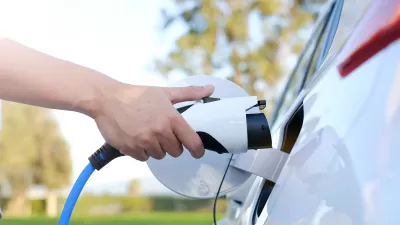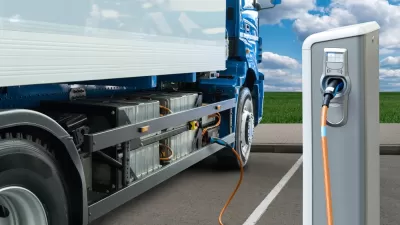The partisan divide over how government should reduce greenhouse gas emissions was on full display after the Biden administration finalized its emissions standards rule for light and medium duty vehicles on March 20.

Update: On March 29, the U.S. Environmental Protection Agency announced final national greenhouse gas pollution standards for heavy-duty vehicles for model years 2027 through 2032. Sen. Pete Ricketts (R-Neb.) announced on the same day that he will introduce legislation to overturn the rule.
The “multi-pollutant emissions standards for model years 2027 and later light-duty and medium-duty vehicles” that were finalized by the Environmental Protection Agency on March 20 will take effect 60 days after publication in the Federal Register.
Related in Planetizen:
- How New Federal Rule Could Impact EV Adoption, March 22, 2024
- Federal Fuel Economy Rules Take Different Path than Emission Standards, August 3, 2023
- Can Federal Emissions Standards Hasten the Transition to EVs? April 17, 2023
But for how long?
“The proposal will essentially remake the U.S. auto industry if it goes forward and it promises to become a major fault line in the 2024 presidential campaign,” said Paul Gigot, editorial page editor of The Wall Street Journal, in a podcast (with transcript) on March 21.
Coral Davenport, energy and environmental reporter for The New York Times, dealt with the upcoming election in her piece, “What to Know About the Clean Auto Rule: It’s Not a Ban on Gas Cars,” published March 20:
Trump could roll back the rule, but not quickly or easily
Trump has vowed to “terminate” the Biden administration’s climate rules “on Day 1.” But now that the car rule is final, it will be more difficult and time-consuming, though not impossible, for a future administration to roll it back. And even if it were, the Clean Air Act requires that it be replaced with another rule controlling greenhouse pollution from vehicles.
However, two U.S. senators chose not to wait for Election Day and announced on March 20 that they plan to introduce legislation to repeal this rule and the yet-to-be finalized heavy-duty vehicle emissions standard after both are finalized and submitted to Congress.
U.S. senators Dan Sullivan of Alaska and Pete Ricketts of Nebraska, both Republican members of the Senate Committee on Environment and Public Works, issued a joint statement in the source article for this post:
“This rule is delusional. This is the Biden administration’s attempt to get rid of the internal-combustion engine without congressional authority. Together, we will be introducing Congressional Review Act legislation to overturn Biden’s EV mandate.
See Sen. Ricketts press release: “Biden EPA’s EV Mandate 'Completely Delusional.'”
The Congressional Review Act
Readers may need a refresher course on this 1996 legislation that was popularized during the Trump administration by the 115th Congress. The Congressional Review Act, or CRA, “requires agencies to report the issuance of 'rules' to Congress and provides Congress with special procedures, in the form of a joint resolution of disapproval, under which to consider legislation to overturn rules,” according to the Congressional Research Service's 2-page description [pdf] of the legislation.
However, the joint resolution must be introduced within a specific time frame: during a 60-days-of-continuous-session period beginning on the day Congress receives the rule.
In fact, just such legislation was introduced successfully last year when the tailpipe standards were initially released last spring, as posted on May 30, 2023:
Four House Democrats joined all but one Republican to enact the Congressional Review Act to roll back President Biden's rule on heavy truck pollution approved by the EPA last December. The Senate had earlier narrowly passed the joint resolution.
The next month, President Biden vetoed the legislation.
An election issue
Will the CRA legislation to be proposed by Sens. Sullivan and Ricketts meet the same fate? First they would need to pass the House and Senate, meaning that the emissions rules, what critics like Sullivan and Ricketts call an electric vehicle mandate, will also be an issue in the congressional as well as the presidential campaign.
Not a mandate
Technically, the EPA's emissions standards rule is not a mandate, as the Times' Davenport reminds us:
The rule does not mandate sales of electric vehicles, and consumers can still buy and drive gas-powered cars. Rather, it requires car makers to meet tough new average emissions limits across their entire product lines; it’s up to manufacturers to decide how to meet those limits.
But even without the CRA legislation, the longevity of the rules is questionable, as Davenport notes in the final paragraph:
Its fate is likely to be decided by the Supreme Court
The rules are expected to face an immediate legal challenge by a coalition of fossil fuel companies and Republican attorneys general, complaints that are likely to wind their way to the Supreme Court. The 6-3 conservative majority on the court has, in recent years, taken steps to limit the authority of the E.P.A. In a 2022 decision on another major E.P.A. climate rule, the court sharply limited, but did not strike down, the agency’s authority to limit greenhouse pollution from power plants.
- Related: Supreme Court Guts the U.S. EPA’s Ability to Limit Carbon Emissions, June 30, 2022
- Additional reading in The New York Times: Inside the Republican Attacks on Electric Vehicles, March 21, 2024
FULL STORY: Sullivan, Ricketts Announce Plans To Introduce CRA Reversing Emission Rules For Biden’s Ev Mandate

Study: Maui’s Plan to Convert Vacation Rentals to Long-Term Housing Could Cause Nearly $1 Billion Economic Loss
The plan would reduce visitor accommodation by 25,% resulting in 1,900 jobs lost.

North Texas Transit Leaders Tout Benefits of TOD for Growing Region
At a summit focused on transit-oriented development, policymakers discussed how North Texas’ expanded light rail system can serve as a tool for economic growth.

Using Old Oil and Gas Wells for Green Energy Storage
Penn State researchers have found that repurposing abandoned oil and gas wells for geothermal-assisted compressed-air energy storage can boost efficiency, reduce environmental risks, and support clean energy and job transitions.

Private Donations Propel Early Restoration of Palisades Playground
Los Angeles has secured over $1.3 million in private funding to restore the Pacific Palisades playground months ahead of schedule, creating a modern, accessible space that supports community healing after recent wildfires.

From Blight to Benefit: Early Results From California’s Equitable Cleanup Program
The Equitable Community Revitalization Grant (ECRG) program is reshaping brownfield redevelopment by prioritizing projects in low-income and environmental justice communities, emphasizing equity, transparency, and community benefits.

Planting Relief: Tackling Las Vegas Heat One Tree at a Time
Nevada Plants, a Las Vegas-based nonprofit, is combating the city’s extreme urban heat by giving away trees to residents in underserved neighborhoods, promoting shade, sustainability, and community health.
Urban Design for Planners 1: Software Tools
This six-course series explores essential urban design concepts using open source software and equips planners with the tools they need to participate fully in the urban design process.
Planning for Universal Design
Learn the tools for implementing Universal Design in planning regulations.
Ascent Environmental
Borough of Carlisle
Institute for Housing and Urban Development Studies (IHS)
City of Grandview
Harvard GSD Executive Education
Toledo-Lucas County Plan Commissions
Salt Lake City
NYU Wagner Graduate School of Public Service





























